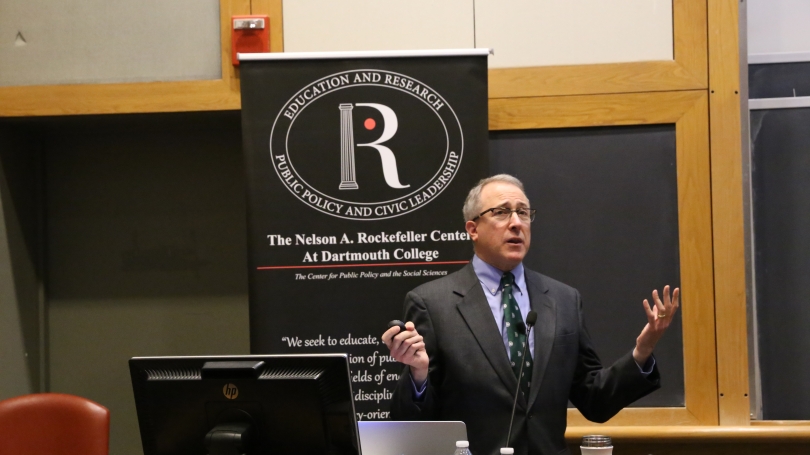
- Public Policy
- Leadership
- Funding
- News & Events
- About the Center
Back to Top Nav
Back to Top Nav
Back to Top Nav
Back to Top Nav
Environmental attorney, 2019 Perkins Bass Distinguished Visitor and former Commissioner of the New Hampshire Department of Environmental Services Tom Burack ’82 arrived at the Rockefeller Center on Oct. 23, 2019 to deliver a talk, “Courageous Government: The Audacity of Collaborative Leadership,” about the importance of collaborative leadership in devising and implementing public policy. “It is only by working together, by collaborating in our efforts to find solutions, that we will find durable and lasting solutions that really allow us to address the big challenges that face us today,” Burack said.
During his time as the Perkins Bass Distinguished Visitor, in addition to speaking to the Rockefeller Center, Burack has visited public policy classes, participated in a panel at the Arthur L. Irving Institute for Energy and Society, and even performed Daniel Webster’s acclaimed peroration in a reenactment of the famous Supreme Court case Dartmouth College v. Woodward.
Burack grew up in Jackson, New Hampshire and developed his interests in government and international relations while at Dartmouth. He was the recipient of the Truman Scholarship award his sophomore year, an opportunity that opened doors for him and pushed him toward public service. After graduating, he worked for several years in the Washington, DC office of then-U.S. Senator Gordon J. Humphrey (R-NH). “It was a really tremendous opportunity to understand how things really got done and what it [takes] to move legislation forward,” Burack said.
He subsequently attended law school at the University of Virginia, clerked for then-Associate Justice David Souter on the Supreme Court of New Hampshire, and practiced law for seventeen years before being appointed environmental commissioner in 2006 by then-governor John Lynch. His time in the executive branch of the state government informed much of his talk. Burack walked the audience through three thought exercises that helped explain the points he made about collaborative leadership.
In the first, he asked audience members to imagine that they were employed at a government agency where they were required to work with another government agency but forbidden to communicate directly with their counterparts. Burack noted that this situation was common when he came into government, observing that “state agencies, more than two dozen, operated largely as fiefdoms” that weren’t always on the same page. “They would take their own positions when, for example, they went to the legislature,” Burack said, “that may or may not line up with what the governor wanted, let alone with what might be in the best interest of other agencies in the executive branch.”
Adding that he found that agency employees and even commissioners often wanted to work together, he and his counterparts in other agencies formed the Commissioners Group in 2009, an unofficial, voluntary group of the agency heads. “The notion was that we as commissioners had a shared mission, we faced a lot of the same challenges, there was a lot we could learn from each other if we just sat down together,” Burack said. The Commissioner’s Group, which still meets regularly today, helps the agencies work together better and form a sense of “camaraderie,” Burack said. The Group also orients and trains new commissioners and helps develop common positions on proposed legislation that may impact multiple agencies. “It was real courage that brought people to say, ‘We can do things better. We can do things differently,’” Burack said.
In the second thought experiment, Burack encouraged audience members to imagine that they are a governor of a state, joking that they had “just been elected to the biggest headache you can ever imagine.” He asked them to come up with ways a single state could make an impact on the major issue of climate change. What one governor – George Pataki of New York – did, Burack said, was to launch the Regional Greenhouse Gas Initiative (RGGI), which created a cap-and-invest system to draw down over time the greenhouse gas emissions of the power sector in the Northeast. Under this system, power plants that emit carbon dioxide have to purchase enough allowances from the states involved to cover their emissions, effectively putting a price tag on carbon pollution. The proceeds are invested in energy efficiency and renewable energy projects, as well as rebates to energy consumers.
“What we found was that by bringing these environmental regulatory agencies together, they could come up with an approach that would work,” Burack said, adding that the costs of administering the program were shared amongst the states. RGGI appears to have made a difference. Burack showed a graph demonstrating the declines in carbon dioxide emissions following the inception of the program – and, importantly, showing that GDP continued to climb.
The third thought experiment asked the audience members to imagine themselves as the head of a state or federal agency, again having trouble with interagency communication. He suggested that the solution would involve something like the initiative he helped launch in 2013 called “E-Enterprise for the Environment,” which seeks to assist the federal Environmental Protection Agency (EPA), states, and tribal governments in working together to increase productivity, streamline processes, and provide trusted information. “This is really about bringing together shared governance, continuous process improvement … as well as bringing technology to bear where it’s appropriate,” Burack said. He said that in an era in which the EPA could no longer “go it alone,” it was crucial to have a shared mechanism for coordinating efforts across political boundaries and hierarchies.
“It’s really about changing cultures and changing behaviors,” Burack added. In an era of increased political polarization and distrust of the government, an approach like Burack’s is a welcome one. Perhaps, as even more states and agencies come to realize that they can’t work alone, Burack’s suggestions will be adopted further.
Written by Kyle Mullins ’22, Rockefeller Center Student Program Assistant for Public Programs